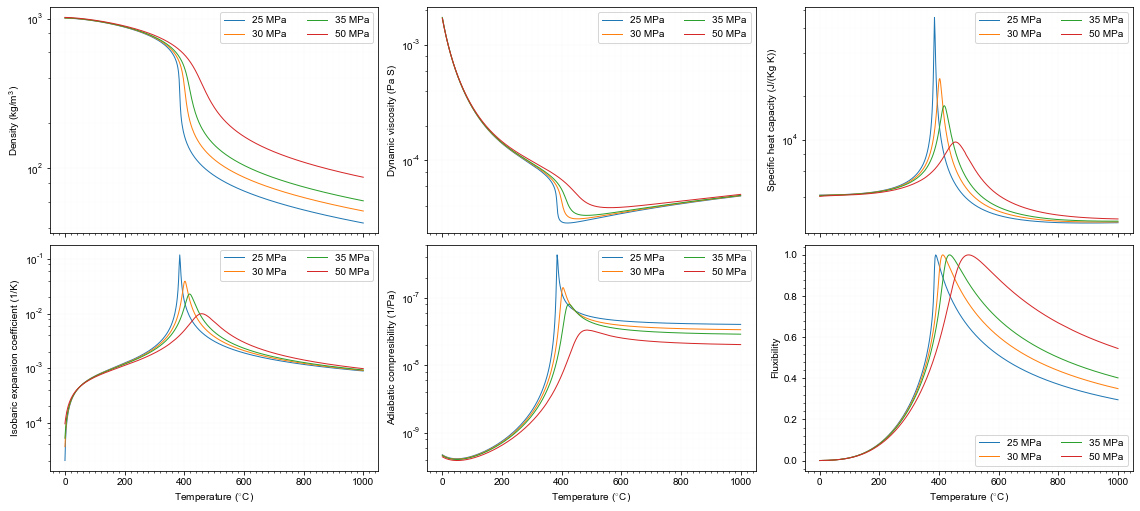T=np.linspace(0, 1000, 500) # deg.C
P=np.array([25, 30, 35, 50]) # MPa
def calProp(T, P0):
rho=np.zeros_like(T)
mu=np.zeros_like(T)
cp=np.zeros_like(T)
h=np.zeros_like(T)
alpha=np.zeros_like(T)
beta=np.zeros_like(T)
F=np.zeros_like(T) #Fluxibility
for i in range(0,len(T)):
steam=iapws.IAPWS97(P=P0, T=T[i]+273.15)
rho[i]=steam.rho
mu[i]=steam.mu
cp[i]=steam.cp*1000
h[i]=steam.h*1000
alpha[i]=steam.alfav
beta[i]=steam.kappas * 1E-6
F[i]=(1100 - rho[i])*rho[i]*h[i]/mu[i]
return rho, cp, mu, h, alpha, beta, F
def plotProp_P0(P0,**kwargs):
rho, cp, mu, h, alpha, beta, F=calProp(T,P0)
# rho
axs[0][0].semilogy(T,rho,label='%.0f MPa'%P0,**kwargs)
axs[0][0].set_ylabel('Density (kg/m$^{\mathregular{3}}$)')
# mu
axs[0][1].semilogy(T,mu,label='%.0f MPa'%P0,**kwargs)
axs[0][1].set_ylabel('Dynamic viscosity (Pa S)')
# cp
axs[0][2].semilogy(T,cp,label='%.0f MPa'%P0,**kwargs)
axs[0][2].set_ylabel('Specific heat capacity (J/(Kg K))')
# alpha
axs[1][0].semilogy(T,alpha,label='%.0f MPa'%P0,**kwargs)
axs[1][0].set_ylabel('Isobaric expansion coefficient (1/K)')
# beta
axs[1][1].semilogy(T,beta,label='%.0f MPa'%P0,**kwargs)
axs[1][1].set_ylabel('Adiabatic compresibility (1/Pa)')
# fluxibility
axs[1][2].plot(T,(F-F.min())/(F.max()-F.min()),label='%.0f MPa'%P0,**kwargs)
axs[1][2].set_ylabel('Fluxibility')
# plot
fig,axs=plt.subplots(2,3,sharex=True,sharey=False,
gridspec_kw={"width_ratios":[1,1,1],"height_ratios":[1,1],'hspace':0.05,'wspace':0.15},
figsize=(16,7))
for P0 in P:
plotProp_P0(P0, lw=1)
# set axis
for i in range(0,2):
for j in range(0,3):
axs[i][j].legend(ncol=2)
ax=axs[i][j]
ax.xaxis.set_major_locator(MultipleLocator(200))
ax.xaxis.set_minor_locator(MultipleLocator(20))
if((i==1) & (j==2)):
ax.yaxis.set_major_locator(MultipleLocator(0.2))
ax.yaxis.set_minor_locator(MultipleLocator(0.04))
else:
ax.yaxis.set_major_locator(mpl.ticker.LogLocator(base=10.0, subs=(1.0,),numticks=20))
ax.yaxis.set_minor_locator(mpl.ticker.LogLocator(base=10.0, subs=(0.2,0.4,0.6,0.8),numticks=20))
ax.grid(which='major',color='gray',lw=0.03)
ax.grid(which='minor',color='lightgray',lw=0.03)
axs[1][j].set_xlabel('Temperature ($^{\circ}$C)')
plt.subplots_adjust(left=0.04,right=0.98,bottom=0.07,top=0.99)
plt.savefig(path_figures+'/Properties_Water.pdf')
plt.savefig(path_figures+'/Properties_Water.svg')
plt.show()
